15-7 A comet is a chunk of ice and dust that partially vaporizes as it passes near the Sun
 Just as heat from the protosun produced two classes of planets, the terrestrial and the Jovian, two main types of small bodies formed in the solar system. Near the Sun, interplanetary debris consists of the rocky objects called asteroids or meteoroids. Far from the Sun, where temperatures in the early solar system were low enough to permit ices of water, methane, ammonia, and carbon dioxide to form, interplanetary debris took the form of loose collections of ices and small rocky particles. These objects are like icy versions of “rubble pile” asteroids such as 253 Mathilde, which we described in Section 15-3. The Harvard astronomer Fred Whipple, who devised this model in 1950, called them “icy conglomerates” or “dirty snowballs.” Some of these “snowballs” are trans-Neptunian objects that orbit forever in the outer regions of the solar system. Some of them, however, are in noncircular orbits that take them inward toward the Sun, where the ice begins to evaporate. These objects are known as comets.
Just as heat from the protosun produced two classes of planets, the terrestrial and the Jovian, two main types of small bodies formed in the solar system. Near the Sun, interplanetary debris consists of the rocky objects called asteroids or meteoroids. Far from the Sun, where temperatures in the early solar system were low enough to permit ices of water, methane, ammonia, and carbon dioxide to form, interplanetary debris took the form of loose collections of ices and small rocky particles. These objects are like icy versions of “rubble pile” asteroids such as 253 Mathilde, which we described in Section 15-3. The Harvard astronomer Fred Whipple, who devised this model in 1950, called them “icy conglomerates” or “dirty snowballs.” Some of these “snowballs” are trans-Neptunian objects that orbit forever in the outer regions of the solar system. Some of them, however, are in noncircular orbits that take them inward toward the Sun, where the ice begins to evaporate. These objects are known as comets.
The Structure of a Comet
Kuiper belt objects and asteroids travel around the Sun along roughly circular orbits that lie close to the plane of the ecliptic (see Figure 2-14). In sharp contrast, comets travel around the Sun along highly elliptical orbits inclined at random angles to the ecliptic. Comets are just a few kilometers across, so when they are far from the Sun they are difficult to spot with even a large telescope. As a comet approaches the Sun, however, solar heat begins to vaporize the comet’s ices, liberating gases as well as dust particles. The liberated gases begin to glow, producing a fuzzy, luminous ball called a coma that is typically 1 million km in diameter. Some of these luminous gases stream outward into a long, flowing tail. This tail, which can be more than 100 million km in length—comparable to the distance from Earth to the Sun—is one of the most awesome sights that can be seen in the night sky (see Figure 15-25 and the image that opens this chapter).

Comet Hyakutake Using binoculars, Japanese amateur astronomer Yuji Hyakutake first noticed this comet on the morning of January 30, 1996. Two months later, Comet Hyakutake came within 0.1 AU (15 million km, or 9 million mi) of Earth and became one of the brightest comets of the twentieth century. This image was made in April 1996, when the comet’s tail extended more than 30° across the sky (more than 60 times the diameter of the full moon). The stars appear as short streaks because the camera followed the comet’s motion during the exposure.
 Many comets are discovered when they are still far from the Sun, long before their tails grow to full size. A number of these discoveries are made by amateur astronomers, many of whom use only binoculars or small telescopes to aid in their search.
Many comets are discovered when they are still far from the Sun, long before their tails grow to full size. A number of these discoveries are made by amateur astronomers, many of whom use only binoculars or small telescopes to aid in their search.
Figure 15-26 depicts the structure of a comet. The solid part of the comet, from which the coma and tail emanate, is called the nucleus. It is a mixture of ice and dust that typically measures a few kilometers across. Before 1986, no one had seen the nucleus of a comet. It is small, dim, and buried in the glare of the bright coma. In that year, the first close-up pictures of a comet’s nucleus were obtained by a spacecraft that flew past Comet Halley (Figure 15-27a). Comet Halley’s potato-shaped nucleus is darker than coal, reflecting only about 4% of the light that strikes it. This dark color is probably caused by a layer of carbon-rich compounds and dust that is left behind as the comet’s ice evaporates.
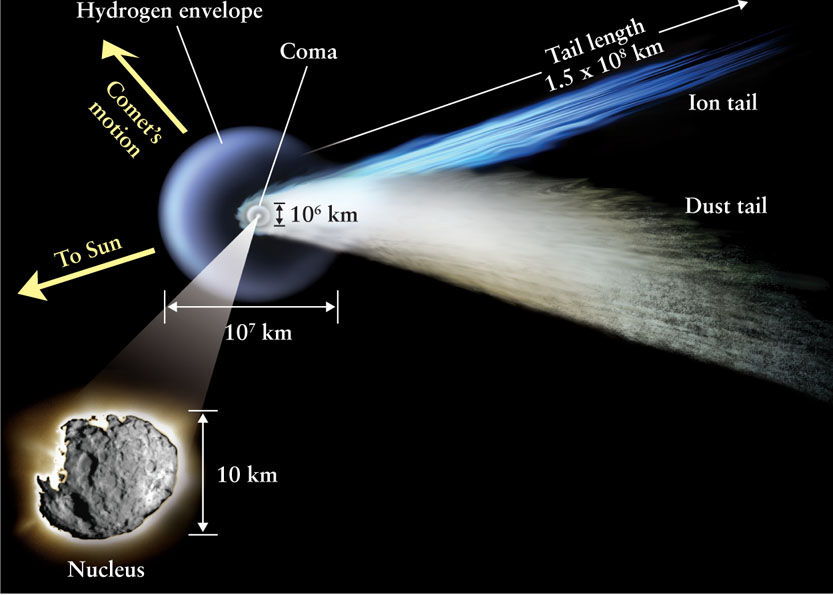
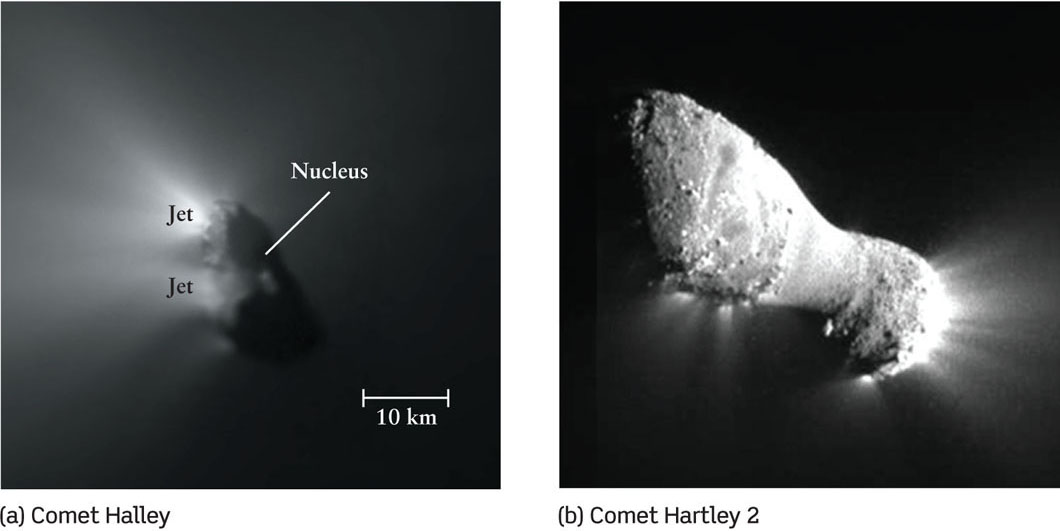
Comet Nuclei and Jets When sunlight reaches exposed ice on the surface of the nuclei, evaporation produces jets. (a) This image from the European Space Agency spacecraft Giotto shows the dark, potato-shaped nucleus of Comet Halley in March 1986. Sunlight from the left illuminates half of the nucleus, which is about 15 km long and 8 km wide. Two bright jets of dust extend from the nucleus toward the Sun. (b) Comet Hartley 2 imaged by NASA’s EPOXI spacecraft. This small comet is only about 1.2 miles wide from end to end. A spectrum of the jets indicates that they emit about 200 kg/sec of water, and even more carbon dioxide.
Several 15-km-long jets of dust particles were seen emanating from bright areas on Comet Halley’s nucleus. These jets seem to be active only when exposed to the Sun. The bright areas, which probably cover about 10% of the surface of the nucleus, are presumably places where the dark layer covering the nucleus is particularly thin. When exposed to the Sun, these areas evaporate rapidly, producing the jets. The jets build the coma, which feeds the comet’s tails. When the nucleus’s rotation brings the bright areas into darkness, away from the Sun, the jets shut off.
420
In 2010, NASA’s EPOXI mission flew by Comet Hartley 2 (Figure 15-27b) and measured the wavelength spectrum of light coming from the jets that stream off its nucleus. Earlier data indicated that within the jets, water evaporates at a rate of about 200 kg/sec (440 lbs/sec), and water’s evaporation was thought to power the jets. However, the spectrum measured by EPOXI reveals that there is a lot of carbon dioxide (CO2) in the jets as well. Carbon dioxide undergoes the same transformation as water, changing from solid form (familiar as “dry ice”) directly to vapor, when exposed to sunlight. Surprisingly, it appears that the evaporation of carbon dioxide powers the jets even more than water.
After imaging comets and analyzing their composition with spectra, the next steps in exploration are to sweep up material from their jets, smash projectiles into their surfaces, and even land on their surfaces for detailed analysis.
Sweep, Smash, and Land
In 2006, NASA’s Stardust probe crashed to Earth. Far from being an accident, Stardust’s landing was the final phase of a huge success after having swept up dust surrounding the nucleus of Comet Wild 2 (Figure 15-28). Some of the most interesting materials collected from the comet are amino acids. We already saw in Section 15-6 that amino acids are present in some meteorites as well; both comets and asteroids contain these basic building blocks of life.

Comet Wild 2 (a) This picture shows two images combined. The inner portion is a high-resolution photograph showing the surprisingly heavily cratered comet. The bright outer portion shows gas and dust jetting away from the comet. Its tails are millions of kilometers long. (b) A substance called aerogel was used to capture particles from Comet Wild 2’s dust tail. A piece of space debris pierced the aluminum foil holding the aerogel and embedded in it, along with pieces of the foil. (c) A 2-μm piece of comet dust, composed of a mineral called forsterite. On Earth this mineral is used to make gems called peridot.
421
The Stardust mission also undermines the long-held notion that comets never get warm enough to contain liquid water. In 2011, analysis of samples revealed minerals that could only form in liquid water, indicating that the full story on comets is still far from clear.
 To assess the structural properties of a comet, a mission was designed to smash a projectile into a comet’s surface and analyze the debris. To carry out this bold mission, the Deep Impact spacecraft flew to within 500 km of Comet Tempel 1 in 2005 (Figure 15-29). Then, Deep Impact launched a 372-kg copper projectile that slammed into the surface of the nucleus at 37,000 km/h (23,000 mi/h). The collision excavated about 11,000 tons of material from the nucleus for analysis. The character of the ejected material confirmed that the nucleus of Tempel 1 is not held together by chemical forces (the way a solid block of ice is held together). Instead, the nucleus is like a “rubble pile” and is held together by gravitational forces between numerous parts.
To assess the structural properties of a comet, a mission was designed to smash a projectile into a comet’s surface and analyze the debris. To carry out this bold mission, the Deep Impact spacecraft flew to within 500 km of Comet Tempel 1 in 2005 (Figure 15-29). Then, Deep Impact launched a 372-kg copper projectile that slammed into the surface of the nucleus at 37,000 km/h (23,000 mi/h). The collision excavated about 11,000 tons of material from the nucleus for analysis. The character of the ejected material confirmed that the nucleus of Tempel 1 is not held together by chemical forces (the way a solid block of ice is held together). Instead, the nucleus is like a “rubble pile” and is held together by gravitational forces between numerous parts.
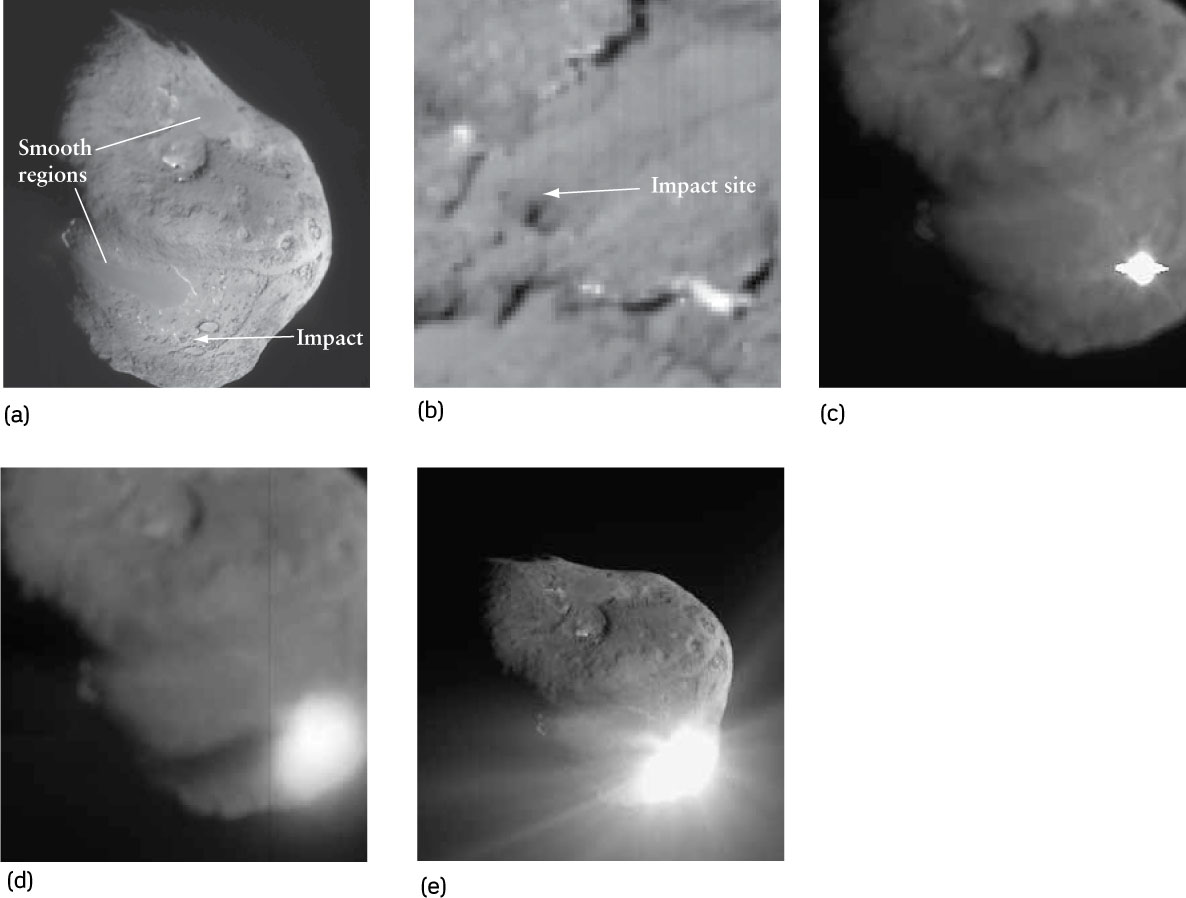
Comet Tempel 1 (a) This composite image of Comet Tempel 1 has higher resolution at the bottom, as the projectile from Deep Impact headed in that direction. The smooth regions on the comet have yet to be explained. (b) Thirty seconds before the projectile struck the comet. (c) Seconds after impact, hot debris explodes away from the comet nucleus. The horizontal white streak through the center is where the camera’s CCD became overloaded with light from the event. (d) Moments later, the gases and dust were expanding outward. (e) An image taken 67 s after impact. Within minutes, the cloud of debris became much larger than the entire nucleus.
The Deep Impact mission also measured the mass and hence the density of the comet nucleus. The very low density of 600 kg/m3 (60% of the density of water) shows that the nucleus cannot be solid. It is best regarded as a porous jumble of rock, fine dust, and ice.
An even more ambitious mission to explore a comet is the European Space Agency’s Rosetta. This spacecraft was launched in 2004 and is scheduled to intercept Comet 67P/Churyumov-Gerasimenko in 2014. If all goes well, Rosetta will go into orbit around the comet nucleus and release a small probe that will actually land on the nucleus. Due to the low gravity around a comet, tethered harpoons will be fired into the surface to prevent the lander from bouncing off into space. In addition to studying the comet’s overall characteristics, the lander is designed to detect organic molecules (including amino acids) and some of their subtle properties. By comparing the results to organic molecules on Earth, Rosetta will help us assess whether or not some of the organic molecules found in living organisms on Earth could have actually come from comets.
Comet Envelopes and Comet Tails
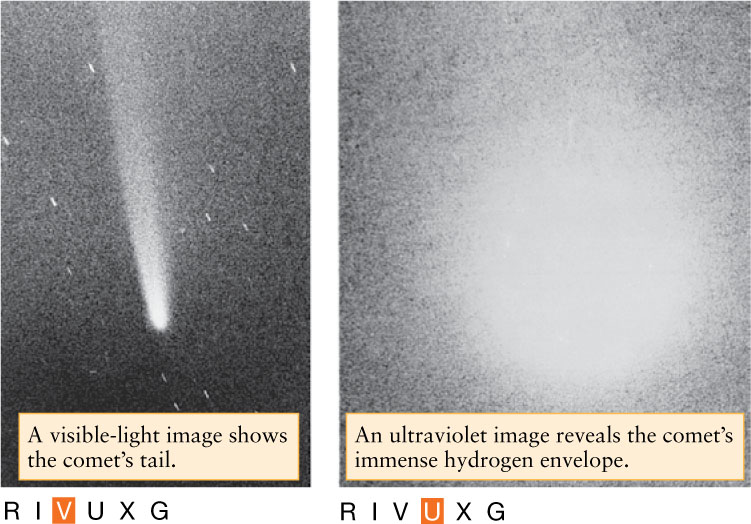
A part of a comet that is not visible to the human eye is the hydrogen envelope, a huge sphere of tenuous gas surrounding the nucleus (Figure 15-26). This hydrogen comes from water molecules (H2O) that escape from the comet’s evaporating ice and then break apart when they absorb ultraviolet photons from the Sun. The hydrogen atoms also absorb solar ultraviolet photons, which excite the atoms from the ground state into an excited state (see Section 5-8). When the atoms return to the ground state, they emit more ultraviolet photons.
Unfortunately for astronomers, Earth-based telescopes cannot detect the emission from a comet’s hydrogen envelope because our atmosphere absorbs ultraviolet light (see Section 6-7). Instead, cameras above Earth’s atmosphere must be used. Figure 15-30 shows two views of the same comet, one as it appeared in visible light to Earth-based observers and one as photographed by an ultraviolet camera aboard a rocket. The ultraviolet image shows the enormous extent of the hydrogen envelope, which can span 10 million km.
422
A comet’s tail does not stream behind it; instead, it points generally away from the Sun
As the diagram in Figure 15-26 suggests, comet tails always point away from the Sun. This observation is true regardless of the direction of the comet’s motion (Figure 15-31). The implication that something from the Sun was “blowing” the comet’s gases radially outward led Ludwig Biermann to predict the existence of a solar wind, a stream of particles rushing away from the Sun (see Section 8-5). A decade later, in 1962, Biermann’s prediction was confirmed when the solar wind was detected for the first time by instruments on the Mariner 2 spacecraft (see Figure 11-11).
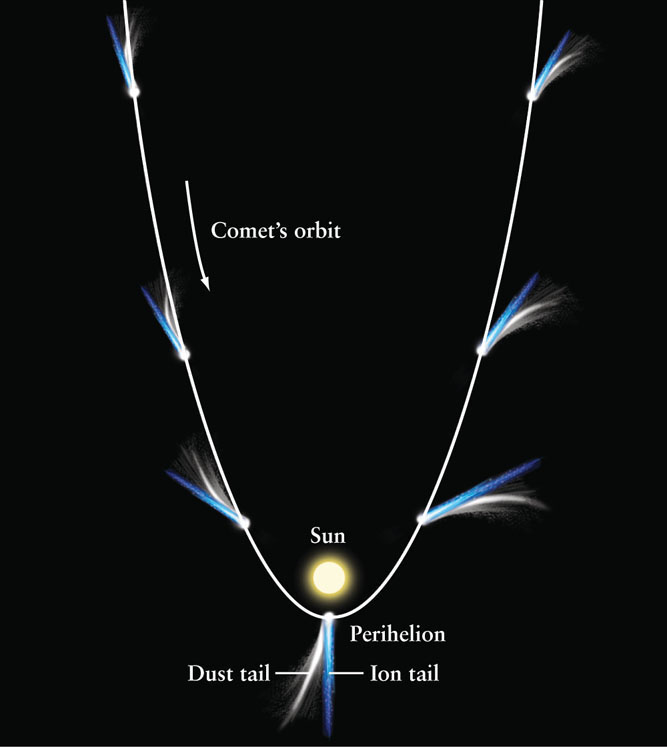
 The Orbit and Tail of a Comet The solar wind and the pressure of sunlight blow a comet’s dust particles and ionized atoms away from the Sun. Consequently, a comet’s tail points generally away from the Sun. In particular, the tail does not always stream behind the nucleus. At the upper right of this figure, the comet is moving upward along its orbit and is literally chasing its own tail.
The Orbit and Tail of a Comet The solar wind and the pressure of sunlight blow a comet’s dust particles and ionized atoms away from the Sun. Consequently, a comet’s tail points generally away from the Sun. In particular, the tail does not always stream behind the nucleus. At the upper right of this figure, the comet is moving upward along its orbit and is literally chasing its own tail.
In fact, the Sun usually produces two comet tails—an ion tail and a dust tail (Figure 15-32). Ionized atoms and molecules—that is, atoms and molecules missing one or more electrons—are swept directly away from the Sun by the solar wind to form the relatively straight ion tail. The distinct blue color of the ion tail is caused by emissions from ionized carbon-bearing molecules such as CN and C2. The dust tail is formed when photons of light strike dust particles freed from the evaporating nucleus. (Figure 8-9 shows a dust particle of this type.) Light exerts a pressure on any object that absorbs or reflects it. This pressure, called radiation pressure, is quite weak but is strong enough to make fine-grained dust particles in a comet’s coma drift away from the comet, thus producing a dust tail. The solar wind has less of an effect on dust particles than on (much smaller) ions, so the dust tail ends up being curved rather than straight. On rare occasions a comet is oriented in such a way that its dust tail appears to stick out in front of the comet (Figure 15-33).

The Antitail of Comet Hale-Bopp In January 1998, nine months after passing perihelion, Comet Hale-Bopp was oriented in such a way that the end of its arched dust tail looked like a spike sticking out of the comet’s head. This spike is called an “antitail” because it appears to protrude in front of the comet.

The Two Tails of Comet Hale-Bopp A comet’s dust tail is white because it reflects sunlight, while the molecules in the ion tail emit their own light with a characteristic blue color. When this picture was taken on March 8, 1997, the ion tail extended more than 10° across the sky. The red object to the right is the North America Nebula, a star-forming region some 1500 light-years beyond the solar system.
After the comet passes perihelion, it recedes from the Sun back into the cold regions of the outer solar system. The ices stop vaporizing, the coma and tail disappear, and the comet goes back into an inert state—until the next time its orbit takes it toward the inner solar system. An object in an elliptical orbit spends most of its time far from the Sun, so it is only during a relatively brief period before and after perihelion that a comet can have a prominent tail. An example is Comet Halley, which orbits the Sun along a highly elliptical path that stretches from just inside Earth’s orbit to slightly beyond the orbit of Neptune (Figure 15-34). The comet’s tail is visible to the naked eye or with binoculars only during a few months around perihelion, which last occurred in 1986 and will happen again in 2061.

 Comet Halley’s Eccentric Orbit Like most comets, Comet Halley has an elongated orbit and spends most of its time far from the Sun. Figure 4-25 shows the comet’s tail, which appears only when the comet is close to perihelion. Comet Halley has been observed at intervals of about 76 years—the period of its orbit—since 88 b.c.e. (see Section 4-7).
Comet Halley’s Eccentric Orbit Like most comets, Comet Halley has an elongated orbit and spends most of its time far from the Sun. Figure 4-25 shows the comet’s tail, which appears only when the comet is close to perihelion. Comet Halley has been observed at intervals of about 76 years—the period of its orbit—since 88 b.c.e. (see Section 4-7).
423
Other comets have orbits that are larger and more elongated, with even longer periods. The orbit of Comet Hyakutake (see Figure 15-25) takes it to a distance of 2,272 AU from the Sun, 50 times the size of Pluto’s orbit, with an orbital period of 108,304 years.
CONCEPT CHECK 15-9
What is the evidence that comets are not mostly solid chunks of ice?